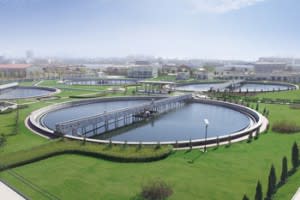SI Research: China Everbright Water – In An Industry Positioned For Growth
Similar to oxygen, water is an important resource for humans as it is necessary for life to exist. The main difference is that oxygen is a byproduct released when plants engage in photosynthesis, while water does not come about that easily. A person stranded in a remote location would hardly be concerned about oxygen, which is readily available in the air, as compared to water and food.
Despite the Earth’s surface being 71 percent covered by water, over 97 percent is made up of the massive bodies of saline seawater in the oceans and only the remaining three percent exists as fresh water. However, around two-thirds of the world’s fresh water is frozen solid in large glaciers and inaccessible for human use.
Naturally, the country that is likely to consume the most water would be the world’s most populous country, China, which has a population of around 1.4 billion making up 18.3 percent of the world population.
In 2016, China’s birth rate increased by 7.9 percent following the end of the one-child policy in 2015 as the country faces a rapidly aging population. The increase fell short of the Chinese government’s expectation and authorities are exploring more ways to boost birth rates.
A higher birth rate leading to a larger population can only bode well for environmental water services companies such as China Everbright Water (CEW).
The Business
Previously known as HanKore Environment Tech Group (HanKore), CEW was formed after China Everbright International injected all of its water assets into HanKore, to become the largest shareholder.
With a market capitalisation of $1.1 billion, CEW is principally engaged in integrated environmental water services, sponge city construction, waste water treatment, reusable water, waste water source heat pump, sludge treatment, research and development of water technologies, engineering and construction. Currently, CEW has invested in and operated water treatment projects with a designed daily water treatment capacity of approximately five million cubic metres.
As an indirect subsidiary of Chinese state-owned China Everbright Group, CEW receives strong support from its parent company and strives to emerge as a leader in the water sector of China.
Financial Performance
2016 marked the start of China’s thirteenth Five-Year Plan. The plan, which calls for environmental protection and more clean energy, seeks to promote a cleaner and greener economy. The favourable environmental protection policies have led to much benefit for CEW.
(Source: Shares Investment)
Revenue has improved tremendously over the years to HK$2.5 billion in FY16 from just HK$1.3 billion in FY13. However, the group reported a weaker net profit for FY16, mainly attributed to high administrative and other operating expenses as well as finance costs.
In to 2017, CEW is on track for a record year with 9M17 revenue already close to that of FY16, while net profit of HK$378 million has already exceeded the previous full year.
Despite the capital-intensive nature of the business, CEW maintains a debt-to-equity ratio of just 1.2 times. Complementing the stable debt-to-equity ratio, the group’s current ratio is at a comfortable level of 1.7 times indicating a state of healthy financial well-being.
Rapid Business Expansion
Building on its established reputation, CEW secured six new projects during 9M17 commanding a total investment of over Rmb1.8 billion ($369 million) and contributing an additional daily designed water treatment capacity of 130,000 tonnes. The group also commenced construction on 11 projects and completed 13 projects, which is expected to further drive the group’s project operation in the coming year.
While most of the newly secured contracts commanded an investment in the millions, the most significant contract win was secured by a consortium led by CEW and Nanning Jianning Water Investment Group for the Nanning Shuitang River Integrated Restoration Public-Private Partnership Project in Guangxi with a total investment of about Rmb1.5 billion ($308 million). CEW will hold a 79 percent equity stake in the project company. The project has a concession period of 22 years including a two-year construction period.
The project is CEW’s first in Guangxi, marking a breakthrough in the southern region of China and potentially paving the way for further business expansion in the region.
Valuation
As at time of writing, CEW’s shares last changed hands at $0.435 per share, putting the valuation of the group’s shares at a trailing 12 months (TTM) price-to-earnings (P/E) ratio of 13.5 times. In addition, based on the group’s current book value per share of $0.51, CEW’s shares are trading at a 15 percent discount to book value.
In comparison, similar industry player Hyflux reported a small net profit of $4.8 million for FY16 and a net loss of $50.4 million for 9M17. SIIC Environment Holdings is trading at a slightly lower TTM P/E ratio of 12.5 times. The average TTM P/E for Singapore-listed companies engaged in the water industry is approximately 20 times.

 Yahoo Finance
Yahoo Finance 


